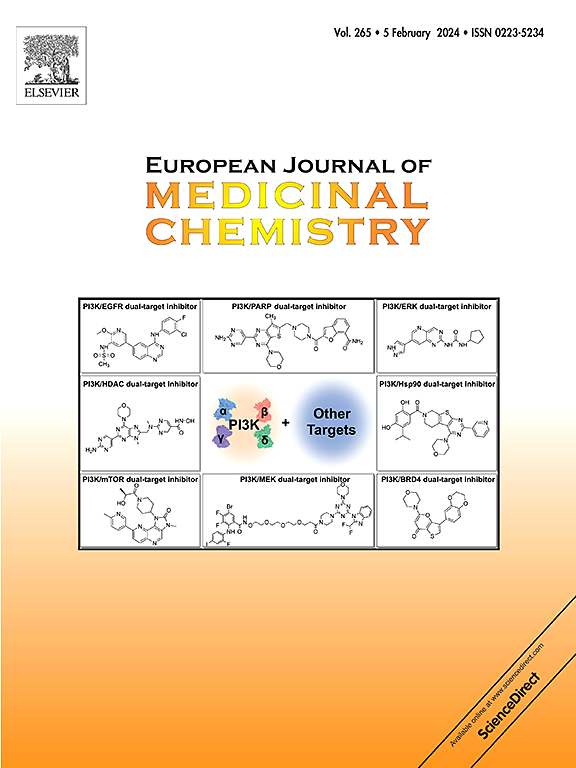Lead optimization of a CHI3L1 inhibitor for Glioblastoma: Enhanced target engagement, pharmacokinetics, and efficacy in 3D spheroid models
IF 5.9
2区 医学
Q1 CHEMISTRY, MEDICINAL
引用次数: 0
Abstract
Glioblastoma (GBM) remains one of the most aggressive and treatment-resistant brain tumors, necessitating the development of novel therapeutics with improved efficacy and pharmacokinetic (PK) profiles. CHI3L1 (chitinase-3-like protein 1) is a secreted glycoprotein overexpressed in GBM, where it promotes tumor progression and immune evasion; however, no small molecule CHI3L1 inhibitors with demonstrated in vivo efficacy in GBM models are currently available. Herein, we present the lead optimization of K284 - a previously reported CHI3L1 inhibitor - toward its application in glioblastoma (GBM) therapy. We employed microscale thermophoresis (MST), surface plasmon resonance (SPR), and molecular docking to design and evaluate novel K284 derivatives targeting GBM. Among the synthesized compounds, 11g emerged as a promising candidate, exhibiting superior CHI3L1 binding affinity and improved PK parameters compared to K284. Notably, 11g demonstrated extended plasma half-lives (t1/2 = 2.5 ± 0.2 h in human and 2.0 ± 0.1 h in mouse) and microsomal stability (t1/2 = 2.8 ± 0.5 h in human and 2.2 ± 0.4 h in mouse), along with reduced intrinsic clearance (Clint = 15 ± 1.2 mL/min/mg in mouse and 19 ± 1.1 mL/min/mg in human). The 11g compound also showed improved solubility, favorable permeability, and decreased plasma protein binding. Safety profiling revealed lower cardiotoxic potential and reduced cytotoxicity toward normal human astrocytes relative to K284. Furthermore, in a 3D multicellular GBM spheroid model, 11g induced dose-dependent cytotoxicity, reduced spheroid mass by over 50 %, and inhibited migration by approximately 60 %, whereas K284 exhibited minimal activity. These findings underscore compound 11g as a potent and multifaceted anti-GBM agent with favorable pharmacological and safety characteristics, warranting further in vivo investigation.

一种用于胶质母细胞瘤的CHI3L1抑制剂的先导优化:在三维球体模型中增强靶向性、药代动力学和疗效
胶质母细胞瘤(GBM)仍然是最具侵袭性和治疗耐药性的脑肿瘤之一,需要开发具有更好疗效和药代动力学(PK)谱的新型治疗方法。CHI3L1(几丁质酶-3样蛋白1)是一种分泌的糖蛋白,在GBM中过度表达,促进肿瘤进展和免疫逃避;然而,目前还没有小分子CHI3L1抑制剂在GBM模型中具有体内疗效。在此,我们提出了K284 -先前报道的CHI3L1抑制剂-用于胶质母细胞瘤(GBM)治疗的先导优化。我们采用微尺度热电泳(MST)、表面等离子体共振(SPR)和分子对接技术设计并评价了靶向GBM的新型K284衍生物。在所合成的化合物中,11g表现出比K284更好的CHI3L1结合亲和力和更好的PK参数,是一个很有希望的候选化合物。值得注意的是,11g延长了血浆半衰期(人体t1/2 = 2.5±0.2 h,小鼠2.0±0.1 h)和微粒体稳定性(人体t1/2 = 2.8±0.5 h,小鼠2.2±0.4 h),同时降低了内在清除率(小鼠Clint = 15±1.2 mL/min/mg,人类19±1.1 mL/min/mg)。11g化合物还显示出更好的溶解度、良好的渗透性和降低血浆蛋白结合。安全性分析显示,与K284相比,K284对正常人类星形胶质细胞的心脏毒性和细胞毒性更低。此外,在3D多细胞GBM球体模型中,11g诱导剂量依赖性细胞毒性,使球体质量减少50%以上,并抑制迁移约60%,而K284表现出最小的活性。这些发现强调化合物11g是一种有效的、多方面的抗gbm药物,具有良好的药理和安全性,值得进一步的体内研究。
本文章由计算机程序翻译,如有差异,请以英文原文为准。
求助全文
约1分钟内获得全文
求助全文
来源期刊
CiteScore
11.70
自引率
9.00%
发文量
863
审稿时长
29 days
期刊介绍:
The European Journal of Medicinal Chemistry is a global journal that publishes studies on all aspects of medicinal chemistry. It provides a medium for publication of original papers and also welcomes critical review papers.
A typical paper would report on the organic synthesis, characterization and pharmacological evaluation of compounds. Other topics of interest are drug design, QSAR, molecular modeling, drug-receptor interactions, molecular aspects of drug metabolism, prodrug synthesis and drug targeting. The journal expects manuscripts to present the rational for a study, provide insight into the design of compounds or understanding of mechanism, or clarify the targets.

 求助内容:
求助内容: 应助结果提醒方式:
应助结果提醒方式:


